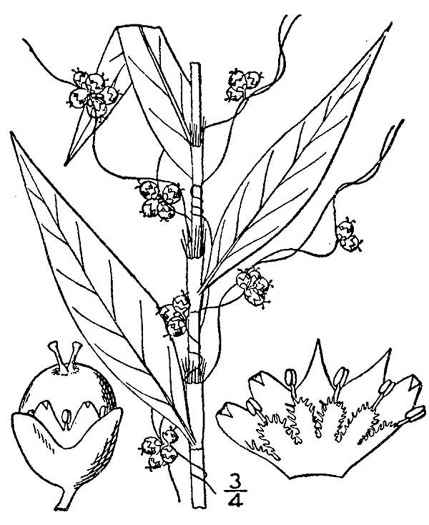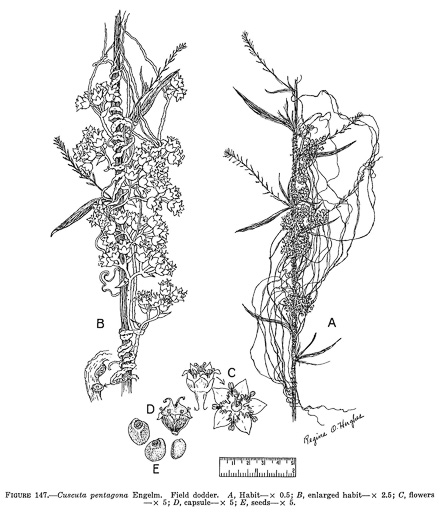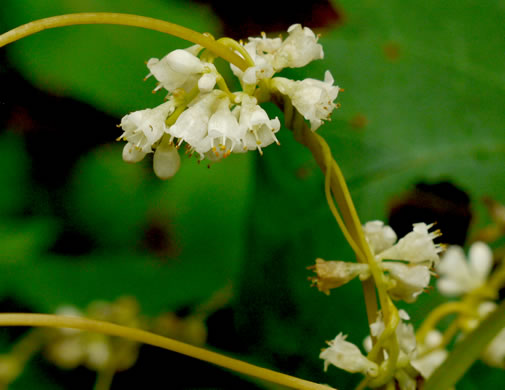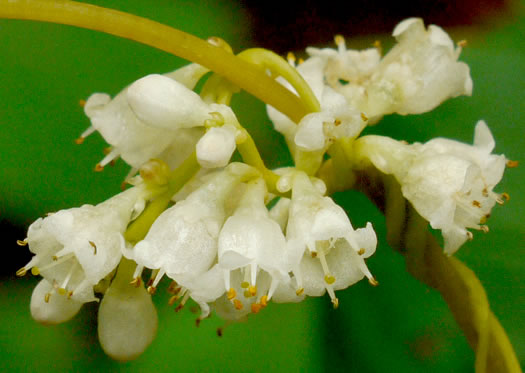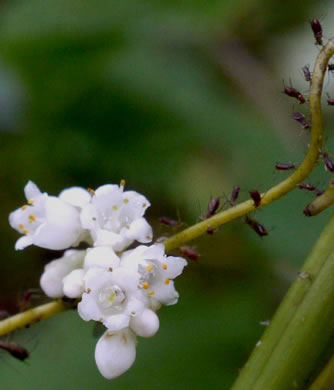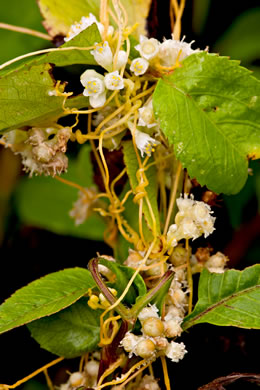Spermatophytes (seed plants): Angiosperms (flowering plants): Eudicots: Core Eudicots: Asterids: Lamiids: Solanales
WEAKLEY'S FLORA OF THE SOUTHEASTERN US (4/24/22):
Cuscuta pentagona
FAMILY
Convolvulaceae
Go to FSUS key
Dig deeper at SERNEC, a consortium of southeastern herbaria.
Check out this Key to the Dodders of Alabama from Daniel Spaulding (Phytoneuron).
Read about the remarkably similar Dodder Laurel from Lytton Musselman and the Southern Appalachian Botanical Society.
Read more about Cuscuta at Vascular Plants of North Carolina.
INCLUDING & INCLUDED WITHIN
PLANTS NATIONAL DATABASE:
Cuscuta pentagona var. pentagona
FAMILY
Cuscutaceae
INCLUDING Floristic Synthesis of North America. BONAP (Kartesz, 2021)
Cuscuta pentagona var. pentagona
INCLUDING Floristic Synthesis of North America. BONAP (Kartesz, 2021)
Cuscuta pentagona var. pubescens
SYNONYMOUS WITH Key to the dodders (Cuscuta, Convolvulaceae) of Alabama and adjacent states (Spaulding, 2013)
Cuscuta pentagona
SYNONYMOUS WITH VASCULAR FLORA OF THE CAROLINAS (Radford, Ahles, & Bell, 1968) 158-01-004:
Cuscuta pentagona FAMILY Convolvulaceae
INCLUDING Gray's Manual of Botany (Fernald, 1950)
Cuscuta campestris
INCLUDING Gray's Manual of Botany (Fernald, 1950)
Cuscuta pentagona
SYNONYMOUS WITH Manual of the Southeastern Flora (Small, 1933, 1938)
Cuscuta pentagona
COMMON NAME:
Five-angled Dodder
To see larger pictures, click or hover over the thumbnails.
JK Marlow jkm140913_712
September Haywood County NC
Blue Ridge Parkway
Pedicels slightly shorter than to longer than flwrs, thus inflorescences loose, per Weakley's Flora.
JK Marlow jkm140913_719
September Haywood County NC
Blue Ridge Parkway
Flowers 5-merous, 1.5-2.5mm long; stems not especially slender, per Weakley's Flora (2012).
JK Marlow jkm140913_726
September Haywood County NC
Blue Ridge Parkway
Calyx lobes overlapping, forming definite angles, thus flowers strongly angled, per Weakley's Flora.
WEAKLEY'S FLORA OF THE SOUTHEASTERN US (4/24/22):
Cuscuta pentagona
FAMILY
Convolvulaceae
INCLUDING & INCLUDED WITHIN
PLANTS NATIONAL DATABASE:
Cuscuta pentagona var. pentagona
FAMILY
Cuscutaceae
INCLUDING
Floristic Synthesis of North America. BONAP (Kartesz, 2021)
Cuscuta pentagona var. pentagona
INCLUDING
Floristic Synthesis of North America. BONAP (Kartesz, 2021)
Cuscuta pentagona var. pubescens
SYNONYMOUS WITH
Key to the dodders (Cuscuta, Convolvulaceae) of Alabama and adjacent states (Spaulding, 2013)
Cuscuta pentagona
SYNONYMOUS WITH
VASCULAR FLORA OF THE CAROLINAS (Radford, Ahles, & Bell, 1968) 158-01-004:
Cuscuta pentagona
FAMILY
Convolvulaceae
INCLUDING
Gray's Manual of Botany (Fernald, 1950)
Cuscuta campestris
INCLUDING
Gray's Manual of Botany (Fernald, 1950)
Cuscuta pentagona
SYNONYMOUS WITH
Manual of the Southeastern Flora (Small, 1933, 1938)
Cuscuta pentagona
If a search such as "Carex leptalea var. leptalea" doesn't deliver the results you want, try "Carex leptalea".
Or, to minimize chances of a misspelling, try just "Carex le".
Less is more: If "pencil flower" doesn't deliver the results you want, try "pencil".

